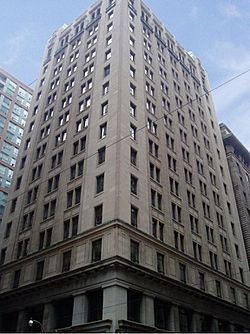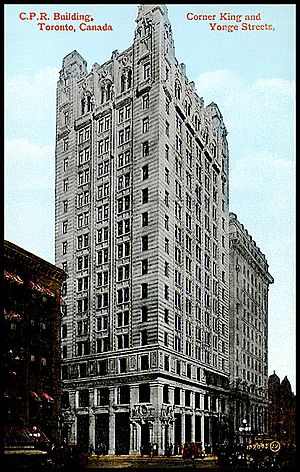Canadian Pacific Building (Toronto) facts for kids
Quick facts for kids Canadian Pacific Building |
|
|---|---|
 |
|
| Alternative names | Canadian Pacific Railway Building |
| General information | |
| Type | Commercial offices |
| Address | 69 Yonge Street Toronto, Ontario M5E 1K4 |
| Coordinates | 43°38′57″N 79°22′39″W / 43.649043°N 79.377564°W |
| Completed | 1913 |
| Height | |
| Roof | c. 85 m (279 ft) |
| Technical details | |
| Floor count | 15 |
| Lifts/elevators | 3 |
| Built | 1911-13, refaced 1929-30 |
| Built for | Canadian Pacific Railway |
| Original use | Corporate Headquarters |
| Architect | Darling and Pearson, assisted by Harkness and Oxley, Engineers |
| Architectural style(s) | Edwardian |
| Designated | 1990 |
The Canadian Pacific Building is a tall, 15-story building located at 69 Yonge Street in Downtown Toronto, Ontario, Canada. It was designed by the famous architecture firm Darling and Pearson. When it was finished in 1913, it became the tallest building in Canada and the entire British Empire. It was built to be the main office for the Canadian Pacific Railway company.
Contents
History of the Building
The Canadian Pacific Building was constructed during a very successful time for the Canadian Pacific Railway. The railway company wanted to bring all its different offices in Toronto into one big building. This new building also had a special ticket office on the ground floor. This made it easy for customers to buy train tickets without having to go all the way to Union Station.
Building Construction
Work on the building started in 1911 and was completed by 1913. The ground floor featured a grand, two-story lobby and the ticket office, both made of marble. Above this, the building housed other important parts of the company, including their busy telegraph business. The railway also rented out extra office space to other businesses. The building was designed in an Edwardian style, which was a new look for the Canadian Pacific Railway.
Changes Over Time
The Canadian Pacific Building was one of four important buildings built around the same time at the corner of King and Yonge Streets in Toronto. All four buildings are still standing today. However, many much taller buildings have been built around them since then. The building was originally covered with a cream-colored material called terra cotta.
By 1929, the fancy terra cotta outside of the building started to have problems. It couldn't handle the cold Canadian winters very well. So, over a year and a half, the building was updated. Its original architects, Darling and Pearson, supervised the work. They replaced the terra cotta from the fourth floor up with a new stone called Indiana Limestone. The original granite on the first three floors stayed the same. Even though the Canadian Pacific Railway no longer owns the building, you can still find traces of its name on the walls.
The railway company owned the building until 1988, when it was sold to a company called H&R Development. This company then renovated the building. As of 2017, a real estate company called H&R Real Estate Investment owns the building. All the office spaces in the building are rented out, offering over 86,000 square feet of office space in total.
Building Design
The 15-story Canadian Pacific Building was designed in a grand style called "Renaissance Revival," following "Beaux Arts principles." This means it was inspired by classic European buildings. It has a strong, fire-proof steel frame. The building is designed in three main parts: a base (called a plinth), a tall middle section (the shaft), and a top section (the attic).
The base has strong columns and fancy trim. It also features four main entrance doors with decorative frames and large windows above them. The tall middle section of the building has many windows that are evenly spaced. The top section, or attic, has a row of paired windows with railings. The very top of the building has a flat roof with decorations at the four corner towers, including small domes called cupolas.
Protecting the Building
The Canadian Pacific Building is considered a very important historic site. It is protected under a special law called the Ontario Heritage Act. The City of Toronto officially recognized it as a heritage property in 1990. This means its special features and history are preserved for the future.
See also
 In Spanish: Canadian Pacific Building para niños
In Spanish: Canadian Pacific Building para niños


